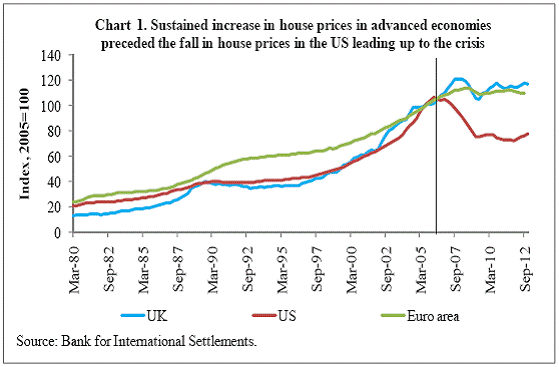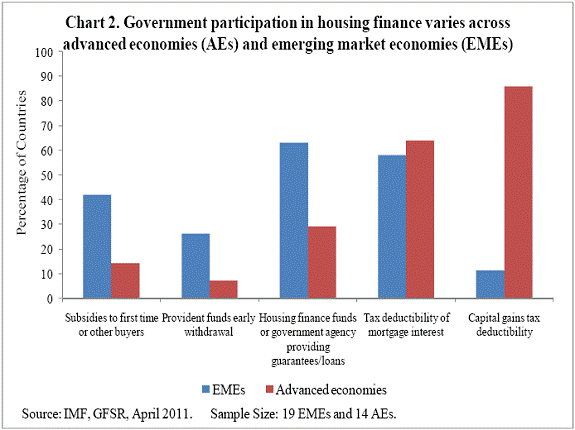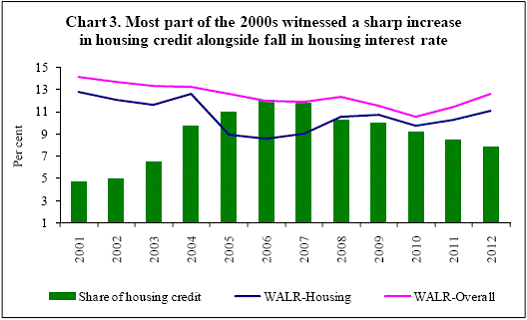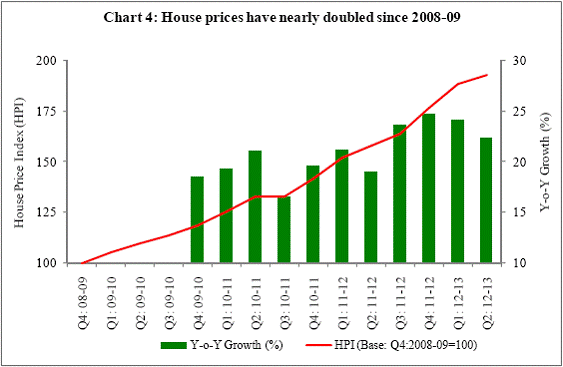 IST,
IST,


Perspectives on Housing Finance in India
Shri Deepak Mohanty, Executive Director, Reserve Bank of India
delivered-on એપ્રિલ 15, 2013
I thank Mr. R.V. Verma, Chairman and Managing Director, National Housing Bank (NHB) for the opportunity to be a part of this distinguished panel on “Housing Finance Post Sub-prime”. Housing is a basic necessity. Yet a large number of households do not have access to decent housing, particularly in a developing country like ours. In view of the importance of housing, a key element of public policy in many countries has been to encourage house ownership largely through fiscal incentives and better availability of housing finance. At the same time, the demand for housing finance has encouraged financial innovations, at times resulting in financial crisis like the recent one. While development of housing finance in advanced countries has a long history, the expansion of housing finance by the formal financial sector in India is of relatively a recent origin. Keeping in view the demand-supply gap, our favourable demography, increasing urbanisation and better growth prospects, the demand for housing finance will continue to grow. The challenge, therefore, is expansion of housing finance to a wider section of the population with the necessary safeguards to preserve financial stability. Against this background, I will touch upon the sub-prime crisis in the US with the objective of distilling the lessons that can be drawn for the development of housing finance. I will then dwell upon the developments in housing finance in India with a particular reference to banks. I will also discuss the initiatives taken by the NHB and the Reserve Bank to develop the statistics on housing finance, particularly house price indices. I will conclude with some thoughts on developing housing finance on the way forward. Sub-prime Lessons Globally, developments in housing markets and house prices have drawn considerable attention in both academic and policy circles in the aftermath of the global financial crisis. The recent global crisis emanated from the sub-prime segment of the US housing market. While the crisis has spread and become broad-based across the globe, the post-crisis recovery has also been predicated on the prospects of the housing sector in many advanced economies. As emphasized in the literature, there are different channels through which housing affects the economy: First, housing wealth constitutes a significant portion of total wealth of households in the advanced economies. For instance, housing wealth accounted for about one-half of household net worth in the US and over two-thirds in the euro area. Hence, any variation in it may have significant impact on households’ consumption and thereby aggregate demand in the economy. Second, housing markets have implications for the supply side of the economy as labour mobility and employment is affected by the housing economy. Third, house prices, like any other asset prices being interest rate sensitive, affect transmission of monetary policy. Finally, boom and bust in house prices have implications for business cycles and hence financial stability. Historically, sharp increases in house prices have been followed by sharp declines after the price bubble bursts. Reinhart and Rogoff (2009) show that the six major historical episodes of banking crises in the advanced economies since the mid-1970s were all associated with a housing bust.1 In the decade preceding the sub-prime crisis, not only did the house price increased substantially, it was also more synchronous across the advanced economies (Chart 1). Thus, sharp increases in house prices over a prolonged period are often predictive of crises in the future. Moreover, the run-up in property prices was also associated with large expansion in credit leading to a substantial increase in household debt. According to the International Monetary Fund (IMF), in the advanced economies, the ratio of household debt to income rose by an average of 39 percentage points to 138 per cent during the 5-year period preceding 2007.2 Cecchetti (2012)3 argues that booms in the prices of assets used as collateral create procyclicality and property price booms tend to be much worse than equity price booms. The institutional structure for housing finance and the role of government differ across countries. It is argued that the key determinants of market depth of housing finance in advanced economies are greater acceptability of housing as collateral and well defined legal rights of borrowers and lenders. The mortgage loans are typically long-term, 20-30 years. But, mortgage interest rates in most cases tend to be linked to short term rates with the provision for periodic resets. There are exceptions, however, such as the US, where long-term fixed-rate mortgage even for 30 years is available. Loan to value ratios (LTVs) also vary widely across countries. Similarly, one can observe significant variation in the degree of governmental participation in the housing market across the advanced countries and EMEs, in terms of subsidies and tax benefits as also measures to provide affordable housing (Chart 2). Notwithstanding the desirability and beneficial role of housing finance, sharp rise in house prices coupled with rapid growth in housing credit does raise concerns in the context of financial stability. Post-crisis it has been argued that central banks should also use macro-prudential tools along with normal interest rate policy to pre-empt excessive rise in house prices to mitigate risks. The instruments that are generally suggested fall under three broad categories: capital-based tools such as, countercyclical capital buffers, sectoral capital requirements and dynamic provisions; liquidity-based tools such as, countercyclical liquidity requirements and asset-side tools such as, caps on loan-to-value (LTV) and debt-to-income (DTI) ratios4. Housing Finance in India Let me now turn to housing in India. As per the Census, during the decade of 2001 to 2011, while housing stock increased by 51 per cent, number of households has increased by 47 per cent. Notwithstanding recent improvements, urban India in 2012 had an estimated shortfall of about 19 million houses. Most of the housing shortage is obviously for economically weaker section (56 per cent) and low income group (39 per cent) people5. Institutional financing for housing in India is dominated by commercial banks. As on March 2012, outstanding housing loans by banks and housing finance companies was Rs.6.2 trillion, of which about two-thirds were accounted for by banks. Overall trend in annual growth of credit of scheduled commercial banks in India indicates that the share of credit for housing in aggregate credit rose from under 5 per cent in March 2001 to 12 per cent by March 2006. This was facilitated by a number of favourable factors: First, sustained reduction in inflation resulted in lowering of lending rates. Second, removal of the restriction of prime lending rate (PLR) as the floor rate for pricing housing loan coupled with reduction in risk weight from 100 per cent to 50-75 per cent for housing loan to individuals aided competitive pricing of such loans. Third, the acceleration in GDP growth raised the demand for housing. Thereafter, the rate of growth in housing credit has moderated. Consequently, its share in total bank credit has declined gradually to about 8 per cent by March 2012. As a percentage of GDP, outstanding housing credit from banks rose from 1.2 per cent in 2001 to a peak of 5.3 per cent in 2006 before moderating to 4.2 per cent by March 2012. The weighted average lending rate (WALR) on housing loan first declined from 12.8 per cent in March 2001 to a low of 8.6 per cent in 2006 before rising to 11.1 per cent by March 2012. Though the interest rate on housing finance has gone up since 2006, it has remained below the overall weighted average lending rate of banks (Chart 3). The moderation in growth of housing credit after 2006 could be attributed to the following factors: First, some slowdown in housing credit growth could be expected after the initial catch-up phase as the pent up demand is met. Second, GDP growth also moderated following the global financial crisis which dampened the demand for housing. Third, the tightening of prudential norms of increasing risk weights to a range of 50-125 per cent, higher provisioning against standard housing assets and prescription of LTV norms to mitigate risks could also have led to some moderation. Notwithstanding tighter prudential standards, direct housing loan of up to Rs. 2.5 million and indirect bank finance to government agencies for rehabilitation of slum dwellers, and to housing finance companies (HFCs) for rehabilitation of slum dwellers as well as for construction of individual dwelling units of up to Rs. 1.0 million are treated as priority sector loans. Government also allows deduction from income up to Rs.0.1 million per annum for principal repayment and Rs. 0.15-0.25 million for interest component for income tax purposes. In addition, there are several specific government schemes for housing for the underprivileged. While these measures have incentivised house ownership, there is a huge gap between demand and supply besides affordability. Let me now turn to house prices which have implications not only for demand but also for financial stability. House Prices Real estate prices are conceptually somewhat different from the prices of goods and services. While prices are generally determined by supply and demand, real estate prices additionally reflect market’s expectations of future prices. As experience shows, if expectations are belied there could be dramatic adjustments in prices raising stability concerns. Compilation of house price indices is challenging not only because of difficulty of gathering accurate price data but also due to quality changes in the construction of similar size of houses even in the same locality. To overcome these challenges, various methods for measuring house prices such as hedonic prices, repeat sales, median prices and sale price appraisal ratio have been developed. It is therefore not feasible to construct a single index that would satisfy all the requirements. The choice of a method therefore is largely influenced by the ease of regular availability of data and the characteristics of the housing market. For example, the Case-Shiller index based on repeat sales data is popular in the US. However, given the predominance of new construction and first time ownership, repeat sales method may not be suitable in the Indian context. In India currently, we have two publicly available House Price Indices (HPIs): (i) NHB-Residex compiled on survey based information for 20 cities, and (ii) RBI-HPI based on registration prices information for 9 cities. The work of compilation of a HPI was initiated by the Reserve Bank in 2007 beginning with Mumbai city. Subsequently, the coverage has been extended to eight more cities: Delhi, Chennai, Kolkata, Bengaluru, Lucknow, Ahmadabad, Jaipur and Kanpur. Apart from data for individual cities, a composite house price index (HPI) covering these 9 cities with base 2008-09:Q4=100 is currently being disseminated by the Reserve Bank on a quarterly basis. As per the Reserve Bank’s composite HPI, house prices have nearly doubled since 2008-09 (Chart 4). Furthermore, the Reserve Bank is also developing a housing asset price monitoring system covering such details as LTV ratio, EMI to income ratio and price to income ratio based on housing loan data from select cities collected from select banks and HFCs. Way Forward Let me now conclude with some thoughts on the way forward. First, besides institutional finance, self financing from private sources, withdrawals from provident funds and loans from employers are important sources of housing finance. The available national accounts data on households’ investment in physical assets do not distinguish between pure households and propriety & partnership concerns. Hence, there is a need to develop a distinct component of pure households’ investment in residential construction for a more comprehensive measure of contribution of housing to households’ net worth. Second, both the NHB-Residex and RBI-HPI, besides providing a cross-check on house prices, facilitate a comparison between final market prices and registration prices. The coverage of the cities needs to be expanded to develop a representative all-India urban house price index. Third, in order to enhance the information base of the housing finance market, the Reserve Bank should place in public domain its detailed database on house price monitoring system. Fourth, keeping in view the recent moderation in expansion of institutional finance for housing, an important question is whether securitization would help in expanding housing finance and also address the problem of procyclicality, thereby stabilizing house prices. As the US experience with the sub-prime crisis shows, securitization could impart liquidity and enhance efficiency only when it leads to creation of simple structures easily understood by market participants and regulators. Given our early stage of development of the mortgage market, there is scope for housing disintermediation both through more active involvement of apex refinancing institutions like the NHB and also through development of simple securitized mortgage products backed by adequate regulatory safeguards. Fifth, in order to mitigate risks in housing finance, besides application of macro-prudential regulations, there is a need to develop a fixed rate housing loan product of longer maturity. Thank you. * Remarks by Shri Deepak Mohanty, Executive Director, Reserve Bank of India, at the International Conference on “Housing: An Engine for Inclusive Growth” organized by the National Housing Bank at New Delhi on April 12, 2013. The assistance provided by A.B. Chakraborty, Ravi Shankar, Abhiman Das and Binod B. Bhoi is acknowledged. 1Reinhart, C. M. and Rogoff, K. S. (2009), This Time is Different : Eight Centuries of Financial Folly, Princeton University Press, New Jersey, as cited in the Global Financial Stability Report, IMF, April 2011. 2International Monetary Fund (2012), “Dealing with Household Debt”, Chapter III, World Economic Outlook, April. 3Cecchetti, S. G. (2012), “Closing Remarks: Property Markets and Financial Stability – Issues and Interpretations”, Conference Volume, Reserve Bank of Australia. 4Report of the Working Group (Chairman: José Manuel González-Páramo) established by the Committee on the Global Financial System, “Operationalising the selection and application of macroprudential instruments” CGFS Papers No. 48, BIS, December 2012. 5Report of the Technical Group on Urban Housing Shortage (TG-12), Ministry of Housing and Urban Poverty Alleviation (Chairman: Amitabh Kundu), Government of India, 2012. |
પેજની છેલ્લી અપડેટની તારીખ:





















